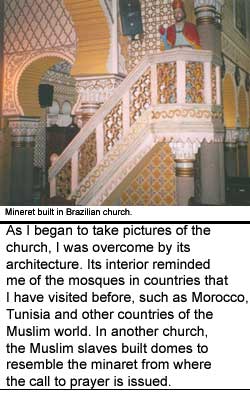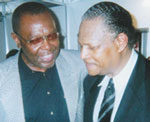
I recently returned from Brazil, which is a beautiful country in South America and a land of nearly 180 million people. The population of the African-Brazilian population has always been in question. The questions are, “is the African population of Brazil 30 percent (or 54 million), 40 percent (or 72 million), or 50 percent (or 90 million)?”
We do know that Brazil is the home of the largest population of Black people in the Diaspora. While the Black Brazilians are mixed into the society, they don’t have any visible leadership positions in large numbers in proportion to their population.
One of the most fascinating things that I found in traveling to Salvador, the capital of the state of Bahia, were the churches built by the Muslims who were slaves. Salvador is the place where the Black population is the most densely populated. It is rich with culture originating from the slaves from various parts of Africa. There are approximately 365 churches in Salvador. It is said by the people “there is one church for every day of the year.”

I met a man who has been living in Brazil for 16 years. He was an Irish expatriate and is married to a Brazilian woman. He noticed my name and told me about a church that was built in 1771 by Muslim slaves. Many of the Muslims who still had the ability to communicate in their mother tongue, i.e., Hausa, Arabic and Yoruba, were some of the great craftsmen. Two churches, in particular, would be of keen interests to not only Muslims, but also those historians and the like who have examined the history of slavery in the Western Hemisphere. In one church the interior has similar motifs as compared to mosques in the Muslim world.
The Muslim slaves had actually built a minbar in the church, which is a place where the imam leads the Ju’umah prayer. Located beneath pictures of Catholic saints are inscriptions in Arabic of Allah’s name. Beneath the crown molding on the interior of the church the Muslims wrote, “In the name of Allah, the Beneficent the Merciful” which was carved in Arabic unbeknownst to those who charged them to build the church. To them, it appeared to be a design made by the people who built the church.
As I began to take pictures of the church, I was overcome by its architecture. Its interior reminded me of the mosques in countries that I have visited before, such as Morocco, Tunisia and other countries of the Muslim world. In another church, the Muslim slaves built domes to resemble the minaret from where the call to prayer is issued.
Although many write on the influence of African religion and its impact on Brazil, very few write about the impact of Islam on Brazilian society and culture. There were many things that I observed that were definitely from Islamic influence; however, it is not mentioned nor is it recorded.
It was interesting to see in Brazilian society the socio-economic position of its tremendous Black population. There were small things that others may not notice, but coming from North America, we noticed quickly. For instance, on my flight to the capital of Bahia, Salvador, which is 80 percent African-Brazilian, the only Black people were my daughter Samimah, her husband George and myself. Upon the return flight from Bahia to Sao Paulo, there was only one Black Brazilian.
In the November 2003 edition of New Africa Magazine, Kwame Arko wrote an excellent editorial entitled “Brazil’s Invisible Blacks.” However, the point that Kwame failed to make was the fact that the new President Luiz In‡cio Lula da Silva (affectionately known as “Lula”) of Brazil has promised to make a change for the poor and the disenfranchised of Brazil.
When one says that he is talking about the masses, the poor and disenfranchised, this would include the Black and indigenous people of Brazil. To reinforce his promise, President Lula recently did a five-nation tour of Africa, the first such tour by a president in the history of Brazil. In his speeches, he emphasized the importance of the historic, cultural and economic links, which he plans to strengthen during his administration.
The Brazilian president has also defended Ms. Benedita de Silva, a prominent African-Brazilian politician, and has kept her in her position, while many were trying to push her out. She is one of the most highly profiled Blacks in Brazil. President Lula, who is socialist and comes from a grassroots background, has been presented with the opportunity to make a difference in Brazil for the African-Brazilians. His election represents a tide of change taking place on the South American continent.
There is an interesting phenomenon happening in South America with the election of President Hugo Chavez in Venezuela, President Lula in Brazil, and the elected new leaders of Bolivia and Peru. All of these heads of states come from grassroots, indigenous backgrounds.
Ironically, most people are not acquainted with the Black populations in these countries, i.e., Bolivia, Peru, Paraguay, Uruguay and Chile. They have not been seen in high political positions and their communities and struggles have not been made visible through the press. These changes give an opportunity to Africans in the Diaspora, as well as those on the continent, to champion the struggle of their brothers and sisters in South America who have suffered and been virtually invisible.
My trip to Brazil, the 118th country to which I have traveled, was most enlightening. The culture of this beautiful country is rich and vibrant. I was invited to a rehearsal of the Bale Folclorico da Bahia (Bahia Folklore Ballet), which is a dance troupe of African-Brazilians from Bahia. The rehearsal was in a small studio in Bahia in the center of the old city. It was probably the most fascinating dance group that I have ever witnessed in my life. Next year, they are planning a tour of America.

I would recommend that everyone who is able to witness this unbelievable performance by these talented young African-Brazilians look them up. Their director, Mr. Walson Botelho, also known as Va Va, told me that they rehearse every single day. That rehearsal manifested itself in the performance that they put on for my daughter, her husband and myself.
I happened to be in Rio de Janeiro just in time for their popular jazz festival. I had the honor to listen and speak with three jazz greats, Mr. Curtis Fuller, Mr. Cedar Waldon and Mr. McCoy Tyner. They all performed at the Rio Jazz Festival. Public Enemy also performed at the close of the festival for an audience of approximately 7,000 people. The people hung on their every word as Chuck D, Flava-flav and Professor Griff brought down the house. After their performance in Rio de Janeiro, they moved on to do the same in Sao Paulo.












